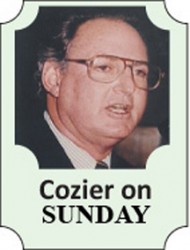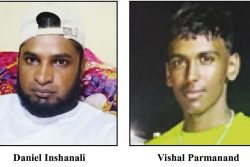For all its global hype, ‘Back to the Future Day’ last Wednesday might just have escaped your attention.
As it was explained in hundreds of newspapers and websites, ‘Back to the Future II’ was the title of a 1989 movie that propelled its two main characters, Marty McFly (played by Michael J. Fox) and Doc Brown forward to October 21, 2015. It was a sequel to an earlier edition when the two made the reverse trip back to 1955. Some of what writer/director Robert Zemecki prophesised have materialised (video chat is now Skype, cars run on alternative fuel, thumbprints can open doors and pay bills, the Chicago Cubs may not be at long last baseball’s World Series champions yet they are in the final playoffs); others (flying cars and skateboards, West Indians will be amused to learn, the banning of lawyers!) will have to wait for ‘Back to the Future III’.
 As the series was out of Hollywood, cricket didn’t merit a mention. The alternatives for the distinctly unAmerican game may be found in the 1980 and 1990 editions of The West Indies Cricket Annual.
As the series was out of Hollywood, cricket didn’t merit a mention. The alternatives for the distinctly unAmerican game may be found in the 1980 and 1990 editions of The West Indies Cricket Annual.
I was the publisher and editor during the Annual’s 21 years existence. For 1980 and 1990, I commissioned articles from an administrator, a player, an umpire, a sponsor and a fan asking them to outline how they saw the coming decade. The separate panels comprised Peter Short and Steve Camacho, the board officiaIs, Deryck Murray and Jeffrey Dujon, the players, Gerry Gomez and Lloyd Barker, the umpires, O.K.Melhado, director of Desnoes and Geddes, the company that brewed Red Stripe and authors John Figueroa and Ian McDonald, the devotees. None of their projections was as fanciful as those of ‘Back to the Future’. They seemed mainly guided by developments in the previous decade. Speaking from understandably different perspectives, administrators and players agreed that their relationship was vital for the wellbeing of the regional game. Through three strikes and down to the latest turmoil over the team’s unprecedented withdrawal of the tour of India last October, the issue has been a destabilizing influence. The dismissal of incumbent captain in India, Dwayne Bravo, and Keiron Pollard from the ODI squad has indirectly yet clearly led to the suspension of head coach Phil Simmons.
Bravo, Pollard and several others are on the books of Indian Premier League (IPL) teams and other domestic T20s franchises not envisaged even at the turn of the 21st century. They have played virtually no WICB cricket in recent times. In a separate article in the 1970s Annual, Peter Short, then president of the Barbados Cricket Association (BCA) and its representative on the West Indies Cricket Board (WICB), was close to the mark when he cautioned about the possible repercussions of the increasing number of West Indians then joining overseas teams. ‘We are delighted they can earn a living playing cricket (but) this does bring with it certain problems,’ he wrote. ‘There is the question of a possible conflict of contracts and this, at times, creates a doubt in the professional’s mind as to whom he should serve.’ The Bravo-Pollard conundrum supports his point 45 years later.
It was a recurring theme in Short’s 1980 contribution. Three years after Kerry Packer’s name was first associated with the game he acknowledged that one of its ‘few good legacies’ was that the players were better and more equitably paid; he identified the problem this time as ‘senior players forming an inflated opinion of their own value’. In his 1980 piece, three years after Packer set up World Series and a year after his accommodation with the Australian board, Murray, the West Indies vice-captain and West Indies Players Association (WIPA) secretary, had an opposite take.
The rapport between board and players had been ‘soured with rancour and mistrust’ by what he termed ‘the war years’ of Packer’s WSC.
‘This must be overcome before anything constructive can be embarked on,’ he wrote. ‘If the West Indies is to flourish in cricket’s New Deal, we need new attitudes and new ideas and we need liberal minds to work for progress.’
Ten years later, Dujon, like Murray wicket-keeper in the golden years of West Indies cricket and WIPA secretary, cited instances that had ‘contributed to strained relations’ with the board. One was the lack of information on the players’ contracts for the inaugural live tv coverage in the home series against England that year. It is the kind of complaint that has resonated down the years; it was the players’ basis for the India tour pullout.
The difficulty, according to Dujon, was caused by a professional team administered by honorary, part-time administrators, conscientious no doubt but without the incentive to devote the time to making West Indies cricket profitable.
It had bred a ‘bad relationship’ between the two and permeated to young players at the start of their careers, rendering it difficult for the board to relate to them and vice-versa.
The WICB is now fully professional with a staff of 32 under an executive president. It has recently forged a new understanding with a previously militant WIPA;, ensuring new financial contracts for those in the revamped first-class tournament, the Professional Cricket League (PCL). Yet several top players, including captains Jason Holder and Darren Sammy, are not WIPA members. To use Murray’s words from 1980, it is a situation that must be overcome ‘before anything constructive can be embarked on’. New attitudes, new ideas and liberal minds are needed to work for progress.
That, it seems, is an item of the agenda for cricket’s ‘Back to the Future III’.
In the meantime, here are a few predictions of my own for what the West Indies game will be like 30 years from now.
For one, there will be no West Indies cricket as we know it. Like the Federation in the 1960s, its various entities would have split and gone their separate ways.
As the only Test cricket would be confined to the game’s oldest rivalry, between England and Australia for the Ashes, Barbados, Guyana, Jamaica and the others would play in their geographical zone of the T20 World T20 Cricket League, possibly also in a corresponding tournament of One-Day Internationals, competing for play-off places against top teams in the other divisions to determine an eventual champions. A unique megastar would emerge from one of the territories. After sprinting to the 100 metres gold medal at the Olympics, he would turn to cricket and develop into a Sobers-like all-rounder (well, wasn’t Usain Bolt once a fast bowler and Yohan Blake a capable batsman?). He may not even be Jamaica.
They are far-fetched forecasts that just came into my head. At least I won’t be around to be ridiculed when they turn out to be hopelessly wrong.








